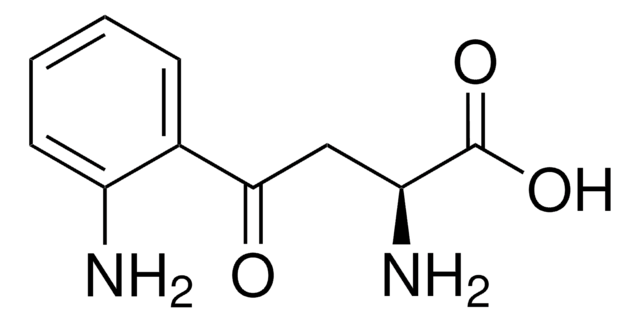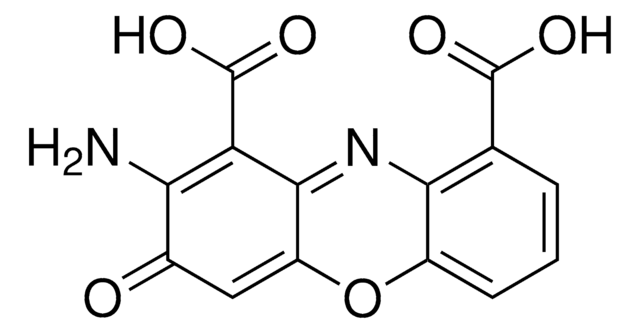すべての画像(1)
About This Item
実験式(ヒル表記法):
C14H8N2O6
CAS番号:
分子量:
300.22
MDL番号:
UNSPSCコード:
12352106
PubChem Substance ID:
NACRES:
NA.25
おすすめの製品
品質水準
アッセイ
≥98% (HPLC)
フォーム
powder
保管条件
desiccated
色
red to very dark red
溶解性
DMSO: ≥4 mg/mL
保管温度
2-8°C
SMILES記法
NC1=C(C(O)=O)C2=Nc3c(OC2=CC1=O)cccc3C(O)=O
InChI
1S/C14H8N2O6/c15-10-6(17)4-8-12(9(10)14(20)21)16-11-5(13(18)19)2-1-3-7(11)22-8/h1-4H,15H2,(H,18,19)(H,20,21)
InChI Key
FSBKJYLVDRVPTK-UHFFFAOYSA-N
アプリケーション
シンナバリン酸は、キヌレニン代謝経路の成分の機能の研究に使用される場合があります。代謝型グルタミン酸受容体(mGlu4R特異的)アゴニストとしての役割を研究するために使用できます。
生物化学的/生理学的作用
カスパーゼインデューサー;mGlu4Rアゴニスト
シンナバリン酸(CA)は、キヌレニン経路の開始と、神経炎症を防ぐために使用される免疫寛容とを結び付けます。
シンナバリン酸(CA)は、キヌレニン経路の開始と、神経炎症を防ぐために使用される免疫寛容とを結び付けます。
シンナバリン酸は、キヌレニン経路によるトリプトファンの代謝産物であり、3-ヒドロキシアントラニル酸の酸化により生成します。シンナバリン酸は、ミトコンドリア呼吸の減少やアポトーシスを引き起こすほか、mGlu4R特異的なアゴニストであることも明らかにされています。
特徴および利点
本製品は、アポトーシス研究のページに記載されています。アポトーシ関連製品について、さらにご覧になるにはここをクリックしてください。その他の研究領域用の生物活性低分子に関する詳細については、sigma.com/discover-bsmをご参照ください。
保管分類コード
11 - Combustible Solids
WGK
WGK 3
引火点(°F)
Not applicable
引火点(℃)
Not applicable
適用法令
試験研究用途を考慮した関連法令を主に挙げております。化学物質以外については、一部の情報のみ提供しています。 製品を安全かつ合法的に使用することは、使用者の義務です。最新情報により修正される場合があります。WEBの反映には時間を要することがあるため、適宜SDSをご参照ください。
Jan Code
SML0096-5MG:
SML0096-VAR:
SML0096-25MG:
SML0096-BULK:
最新バージョンのいずれかを選択してください:
この製品を見ている人はこちらもチェック
S Christen et al.
Biochemistry, 31(34), 8090-8097 (1992-09-01)
Since 3-hydroxyanthranilic acid (3HAA), an oxidation product of tryptophan metabolism, is a powerful radical scavenger [Christen, S., Peterhans, E., & Stocker, R. (1990) Proc. Natl. Acad. Sci. U.S.A. 87, 2506], its reaction with peroxyl radicals was investigated further. Exposure to
U Temp et al.
Applied and environmental microbiology, 65(2), 389-395 (1999-01-30)
When glucose is the carbon source, the white rot fungus Pycnoporus cinnabarinus produces a characteristic red pigment, cinnabarinic acid, which is formed by laccase-catalyzed oxidation of the precursor 3-hydroxyanthranilic acid. When P. cinnabarinus was grown on media containing cellobiose or
Hideaki Iizuka et al.
Biomedical chromatography : BMC, 24(3), 231-234 (2009-07-25)
A fluorimetric detection method for one of the tryptophan metabolites, cinnabarinic acid (CA), which has recently been reported to have the ability to induce apoptosis in thymocytes, was developed using o-tolyl hydrazine (TH) as the derivatization reagent. The carbonyl group
H Ogawa et al.
Hoppe-Seyler's Zeitschrift fur physiologische Chemie, 364(11), 1507-1518 (1983-11-01)
The formation of cinnabarinate in the presence of manganese ions and catalase was investigated spectrophotometrically. The absorption peak of cinnabarinate at 460 nm appeared only in a reaction system containing manganese ions and catalase. If catalase was omitted, a new
H Iwahashi et al.
The Biochemical journal, 251(3), 893-899 (1988-05-01)
Superoxide dismutase (SOD) enhanced the formation of hydroxyl radicals, which were detected by using the e.s.r. spin-trapping technique, in a reaction mixture containing 3-hydroxyanthranilic acid (or p-aminophenol), Fe3+ ions, EDTA and potassium phosphate buffer, pH 7.4. The hydroxyl-radical formation enhanced
ライフサイエンス、有機合成、材料科学、クロマトグラフィー、分析など、あらゆる分野の研究に経験のあるメンバーがおります。.
製品に関するお問い合わせはこちら(テクニカルサービス)








